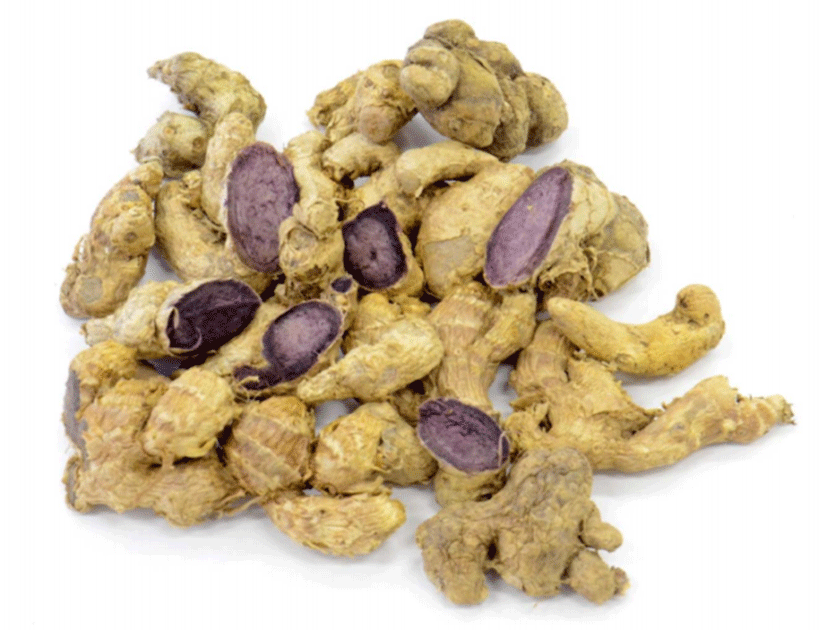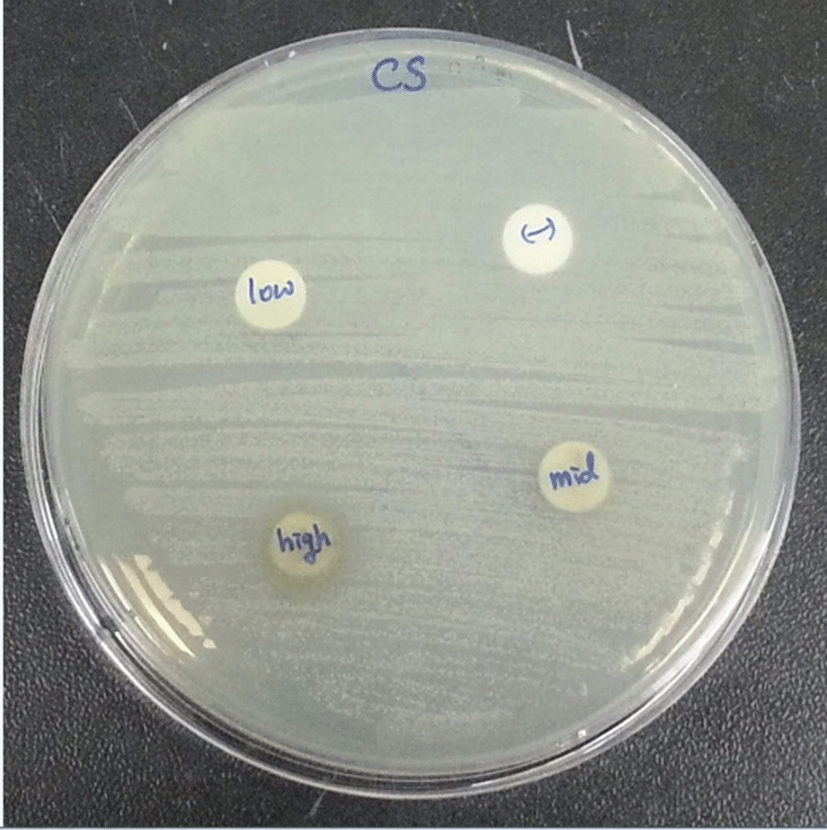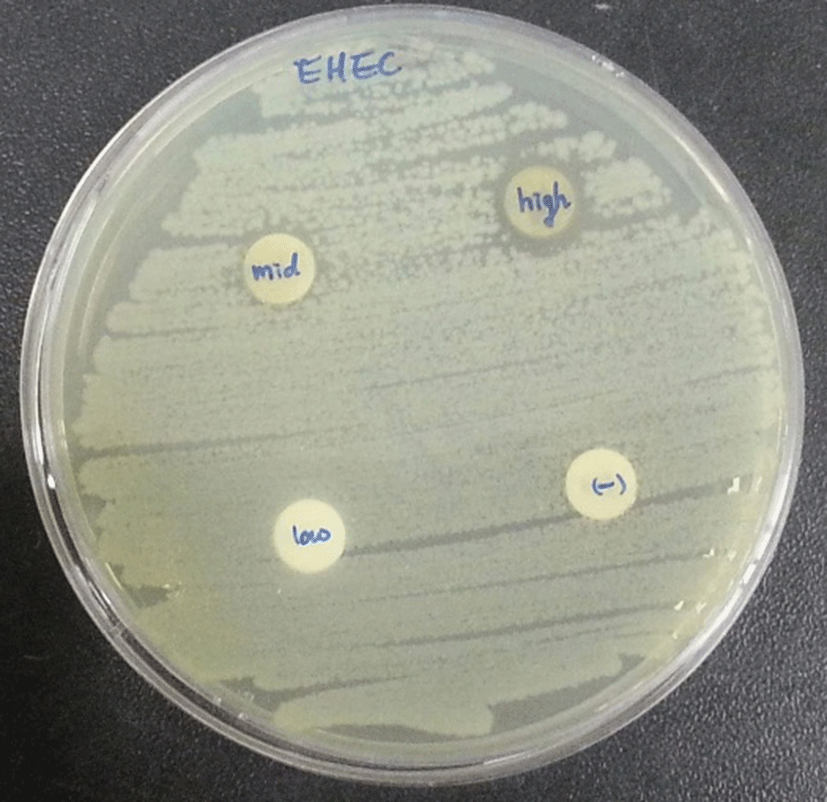Introduction
Medicinal plants are useful alternative source of novel drugs containing various pharmacological activities such as antimicrobial activities, anti-inflammatory, and so on (Welbat et al., 2016). Kaempferia parviflora Wall. Ex Baker (Kaempferia parviflora) or Kra-chai-dam belonging to the Zingiberaceae family is one of the attractive plants for the reasons of various favorable activity (Rujjanawate et al., 2005) (Fig. 1). It has long been used in Thai traditional medicine for antioxidant, antiallergic, antitumor, cardioprotective, allergic, and so on. Furthermore, the extracts and flavone derivatives from the rhizome of Kaempferia parviflora could suppress function of multidrug resistance associated-proteins (MRP), in addition to P-glycoprotein, in cancer cells (Patanasethanont et al., 2006; Patanasethanont et al., 2007).

Also, pharmacological studies have shown that the extract of Kaempferia parviflora rhizomes has antigastric ulcer, antimicrobacterial, and antiviral effects (Rujjanawate et al., 2005; Sookkongwaree et al., 2006). Horigome et al. (2014) reported that Kaempferia parviflora could modulate the expression of multidrug resistance associated-proteins, because Kaempferia parviflora contains 11 polymethoxyflavonoids, 7 of which have been identified as possessing inhibitory effects (Table 1).
Recently, the bacteria, Cronobacter sakazakii is ubiquitous in nature, but can cause severe illness or death in newborn babies if it is ingested. The most likely cause for an infection is through contaminated powdered infant formula (PIF) or if the bacteria are present in the water used to mix PIF (Bowen and Braden, 2006). Because Cronobacter sakazakii is found frequently in nature, it is important to sterilize both bottles and the water used to make the formula (FAO/WHO, 2006). Before 2007, this Gram negative rod was known as Enterobacter sakazakii. While the organism has been found in other foods, only PIF has been linked to disease outbreaks, since PIF is not a sterile product (FAO/WHO, 2008). The organism is unusually resistant to desiccation and can be viable for years in a dried state. Premature, low weight and immune compromised infants are at a higher risk of infection. The US Centers for Disease Control and Prevention (CDC) states that typically four to six cases of infant infections with Cronobacter sakazakii occur each year, however in 2011, there were twelve. It is estimated that 40 to 80% of the cases will be fatal (FAO/WHO, 2008). And furthermore, Enterohemorrhagic Escherichia coli (EHEC) serotype O157: H7 is a human pathogen responsible for outbreaks of bloody diarrhea and hemolytic uremic syndrome (HUS) worldwide (Gu et al., 2011). Characteristics of E. coli serotype O157:H7 (EHEC) infection includes abdominal cramps and bloody diarrhea, as well as the life-threatening complication hemolytic uremic syndrome (HUS) (GU et al., 2011; Goldwater and Bettelheim, 2012). Especially, EHEC is often isolated from dairy farms and feedlots, including from house flies, although the latter is not necessarily a mechanical vector (Rahn et al., 1997). Currently no treatment is available for EHEC infections (Goldwater and Bettelheim, 2012). The use of conventional antibiotics exacerbates Shiga toxin-mediated cytotoxicity. In an epidemiology study conducted by the US CDC, patients treated with antibiotics for EHEC enteritis had a higher risk of developing HUS (Goldwater and Bettelheim, 2012).
Until now, there was no report about the inhibition against Cronobacter spp. and Enterohemorrhagic Escherichia coli (EHEC) using the crude extracts from Kaempferia parviflora. Therefore, this study was aimed at investigating the antibacterial activity of Kaempferia parviflora on Cronobacter spp. and Enterohemorrhagic Escherichia coli (EHEC) so as to keep the safety of various dairy foods such as natural additives.
Materials and Methods
Kaempferia parviflora were donated from Department of Animal Science &Technology, College of Animal Bioscience &Technology, Konkuk University in Seoul, Korea. The dried plant rhizome powder was macerated in 95% ethanol for 48 hours with occasionally stirring at room temperature. And then, the soluble ingredients were concentrated by rotary evaporator (RE801C-W, Yamato, JAPAN) at 50℃ until dryness. The yield were obtained for ethanol extraction type. These stock solutions were filtrated through 0.2 mm Millipore and stored at -20℃ before use.
Strains of Cronobacter spp. (C. sakazakii) and Enterohemorrhagic Escherichia coli (EHEC) were obtained from Department of Public Health, College of Veterinary, Konkuk University in Seoul, Korea. Cells were grown on nutrient agar (NA) (Oxoid, UK) overnight. Colonies were transferred into tubes containing cryopreservation fluid according to the instruction of the manufacturer (Original Microbiology Bead Storage System, STS, Technical Service Consultants Limited, UK). The beads were stored at -70℃ until use.
The antibacterial activity of K Kaempferia parviflora were tested on Cronobacter spp. and Enterohemorrhagic Escherichia coli (EHEC) using paper disk diffusion inhibition test. In paper disc diffusion test, sterile paper was soaked in the extract of Kaempferia parviflora for 2 h. One fifth milliliter of a 24 h broth culture (106 cfu/mL) of the bacteria was spread on the surface of gelled sterile Mueller-Hinton agar plates. The paper discs containing the extracts of Kaempferia parviflora (negative control, low, medium, and high concentration) were placed at different areas on the surface of each plate. The extract against the test bacteria was indicated by growth-free “zone of inhibition” near the respective disc.
All experiments were carried out independently in triplicate experiments. The inhibition of various concentration of Kaempferia parviflora ethanol extracts against Cronobacter spp. (C. sakazakii) and Enterohemorrhagic Escherichia coli (EHEC) were evaluated by one way analysis of variance (ANOVA). Statistical significance was accepted at the P = 0.05 level.
Results and Discussion
The ethanol extract of Kaempferia parviflora showed various levels of antibacterial activity when tested by paper disc diffusion method (Fig. 2 and 3). This results obtained showed that ethanol extract exhibited antibacterial activities against Cronobacter spp. and Enterohemorrhagic Escherichia coli (EHEC). With increasing concentration of Kaempferia parviflora’s ethanol extracts, the results produced the larger zones of inhibition against the bacteria tested (P <0.05) (Fig. 2 and 3).


In fact, by this time, several natural materials have been studied for developing natural additives having antibacterial activity by many researchers so as to replace artificial chemical agents. Especially, the efficacy comparison of natural materials was carried out by solvent extraction (methanol, ethanol, water and so on). For example, according to the report of Chaichanawongsaroj et al. (2010), four parts of Kaempferia parviflora’s extracts - (1) volatile oil, (2) hexane, (3) ethyl acetate and (4) methanol - were screened in vitro for the anti-Helicobacter pylori actions. The strongest growth inhibition against all thirteen H. pylori tested was ethyl acetate extract with the minimum inhibitory concentration (MIC) of 32 mg/mL, and the MIC of the extracts from hexane and methanol were 64 mg/mL, while, the MICs of volatile oil was 1,024 mg/mL (Chaichanawongsaroj et al., 2010). And Mbata et al. (2008) reported that the crude extract from Camellia sinensis by methanol and water exhibited antibacterial activities against L. monocytogenes. The methanol extracts of Camellia sinensis showed larger zones of inhibition against L. monocytogenes than the water extract, and also MIC for the water and methanol leaf extract was 0.69 and 0.26 mg/mL, respectively (Mbata et al., 2008).
And furthermore, Kaempferia parviflora had been reported to possess (1) anti-allergic activities, (2) anti-peptic ulcer, (3) anti-viral proteases, (4) anti-inflammatory activity, (5) anti-cancer action against human cholangiocarcinoma, (6) the increasing mating behavior of the rats via the increasing blood flow to the testicular vessel, (7) the suppressing HFD(high fat diet)-induced obesity through increased energy metabolism, (8) the potential for a supplemental use in vascular endothelial health promotion, and so on (Rujjanawate et al., 2005; Sookkongwaree et al., 2006; Tewtrakul and Subhadhirasakul, 2007; Wattanapitayakul et al., 2007; Tewtrakul et al., 2008; Leardkamolkarn et al., 2009; Sae-wong et al., 2009; Trisomboon, 2009; Yoshino et al., 2014). In general, it was suggested that some bioactive flavonoids containing in the rhizome of Kaempferia parviflora was the major active compound comprising of 5-hydroxy-3,7-dimethoxyflavone, 5-hydroxy-7-methoxyflavone, 5-3,7,4’-trimethoxyflavone, 5-hydroxy-7,4’-dimethoxyflavone, 5-hydroxy-3,7,3’4’-etramethoxyflavone, 3,5,7-trimethoxyflavone, 3,5,7,4’-tetramethoxyflavone, 5,7,4’-trimethoxyflavone and 5,7,3’4’-tetramethoxyflavone (Yenjai et al., 2004; Trisomboon, 2009) (Table 1). For example, Bae et al. (1999) reported that some flavonoids derivatives and their metabolite such as cabreuvin, genistein, hesperitin, irisolidone, and ponciretin displayed anti-Helicobacter pylori activity.
In fact, to date, it has been found that the more functions of Kaempferia parviflora. Wattanathorn et al. (2007) reported Kaempferia parviflora had the activities of anxiolytic and antidepression. And recently, Horigome et al. (2014) identified 5,7-dimethoxyflavone (DMF), 5-hydroxy-3,7,3’,4’- tetramethoxyflavone (TMF), estimated 3,5,7-trimethoxyflavone, 5-hydroxy-7,4’-dimethoxyflavone, 3,5,7,4’-tetramethoxyflavone by using GC-MS and LC-MS, and investigated their anti-inflammatory effects in rat basophilic leukemia (RBL-2H3) cells stimulated with an IgE antigen or a calcium ionophore. These results suggested that unknown components within only the 50% ethanol extract from Kaempferia parviflora may possess the anti-inflammatory effects (Horigome et al., 2014). For getting more effective materials extracted from Kaempferia parviflora, it should be carried out comparative experiments of selecting the best from a variety of extraction solutions.
Hence, from now on, it will be conducted studies actively on many natural materials which have various bioactive functions including antibacterial activity as well as prompting human’s health.
In conclusion, the present study demonstrated the potential of Kaempferia parviflora to inhibit the growth of Cronobacter spp. and Enterohemorrhagic Escherichia coli (EHEC) as antimicrobial activity. Therefore, Kaempferia parviflora could be served as the natural resource to develop the antimicrobial agents. However, it needs further investigation to fully understand the precise underlying mechanism including various functions of the crude extract from Kaempferia parviflora (Krachaidam) is warranted, and furthermore, to obtain the safety so as to use natural additional agents for various dairy foods.
